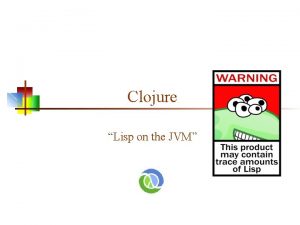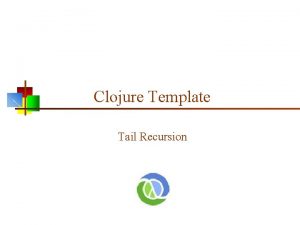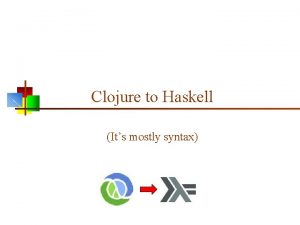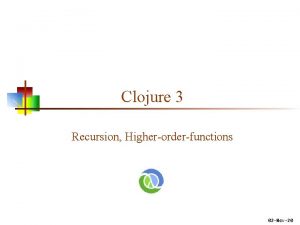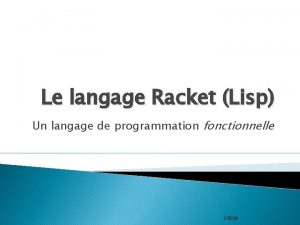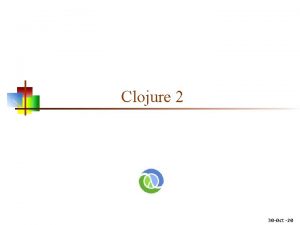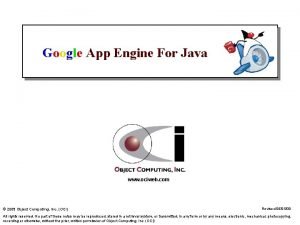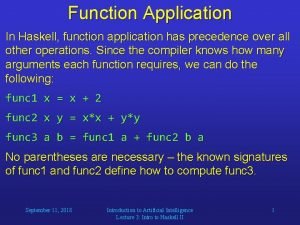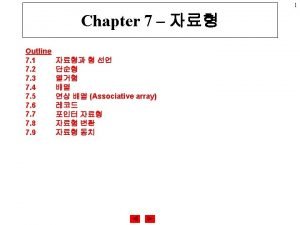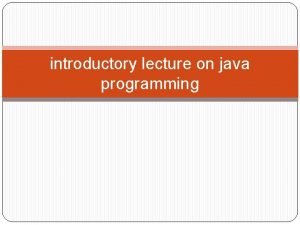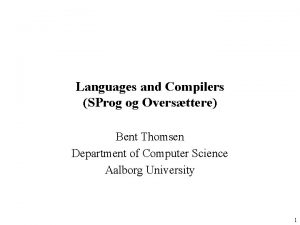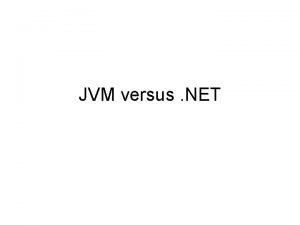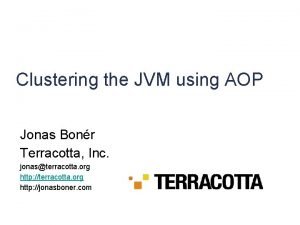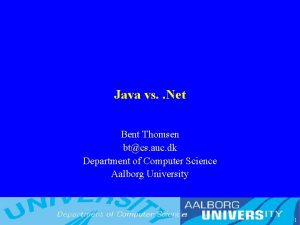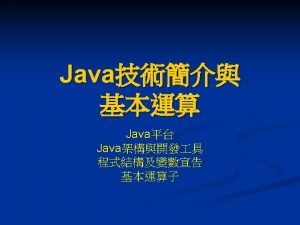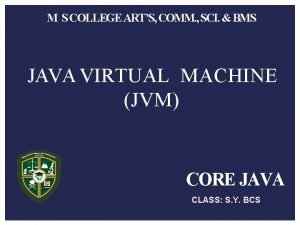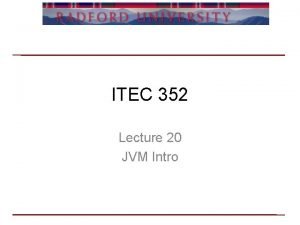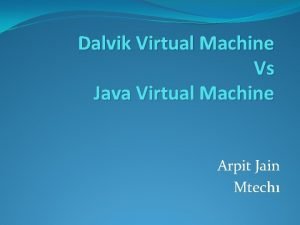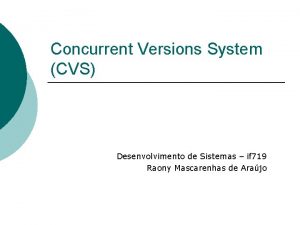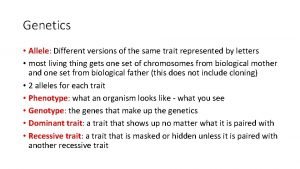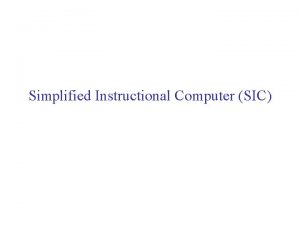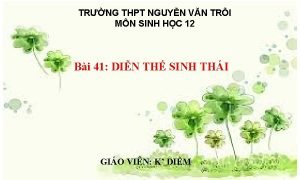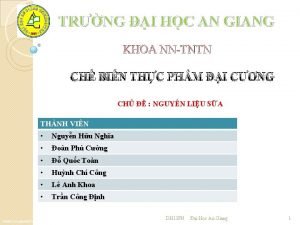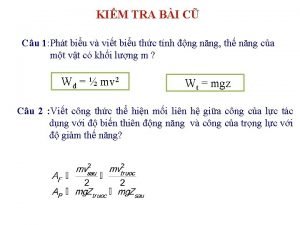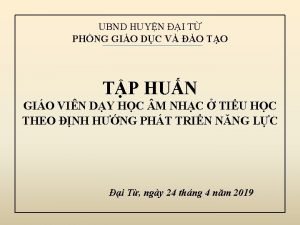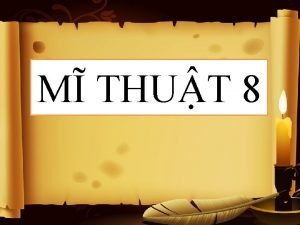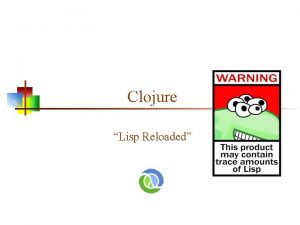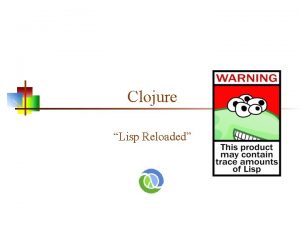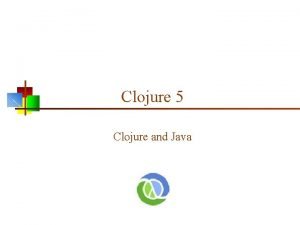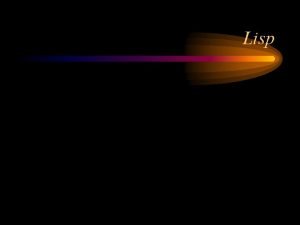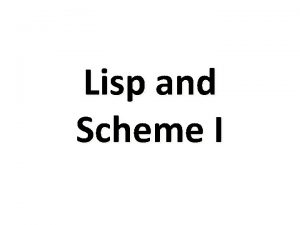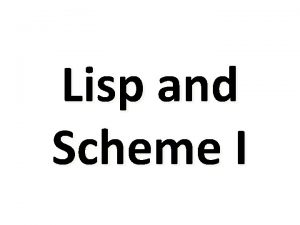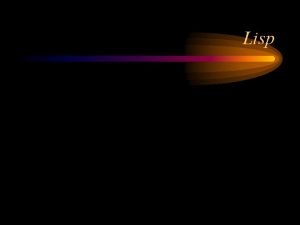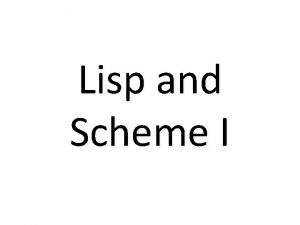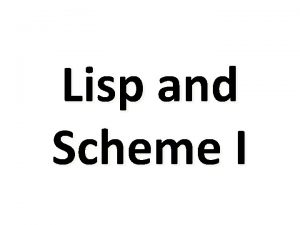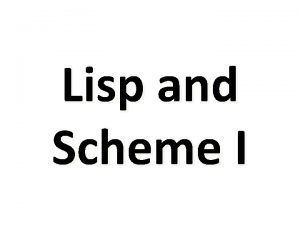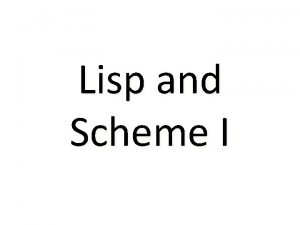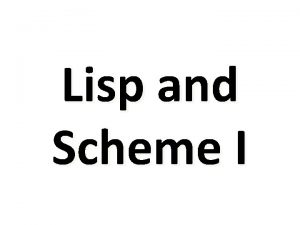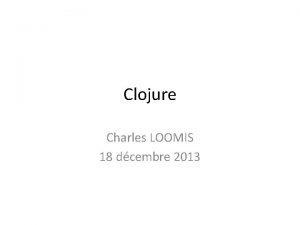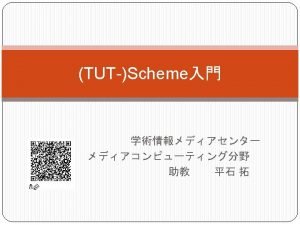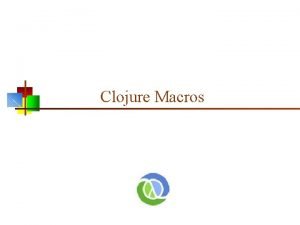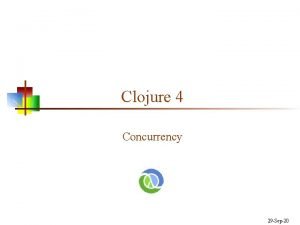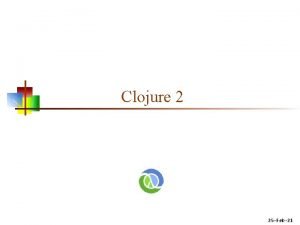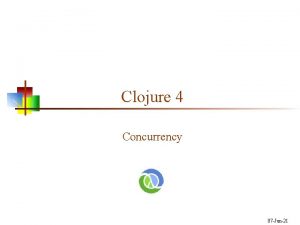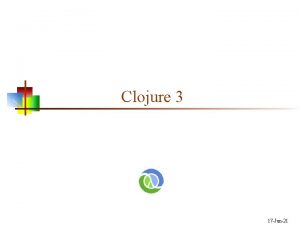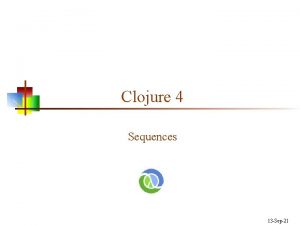Clojure Lisp on the JVM Versions of LISP







![Example (defn say-something [thing] (println “Hello” thing)). . . Show more real code Example (defn say-something [thing] (println “Hello” thing)). . . Show more real code](https://slidetodoc.com/presentation_image/2b2eea853e8b9bdd9ee0addb8f1d9505/image-8.jpg)




![Functions The syntax to define a named function is: (defn function_name [arguments] expressions) The Functions The syntax to define a named function is: (defn function_name [arguments] expressions) The](https://slidetodoc.com/presentation_image/2b2eea853e8b9bdd9ee0addb8f1d9505/image-13.jpg)






![Examples (defn my-first [x] (first x)) user=> (my-first '(1 2 3)) 1 defn my-second Examples (defn my-first [x] (first x)) user=> (my-first '(1 2 3)) 1 defn my-second](https://slidetodoc.com/presentation_image/2b2eea853e8b9bdd9ee0addb8f1d9505/image-20.jpg)



![The problem with if expressions nest rather awkwardly (defn collatz [n] (println n) (if The problem with if expressions nest rather awkwardly (defn collatz [n] (println n) (if](https://slidetodoc.com/presentation_image/2b2eea853e8b9bdd9ee0addb8f1d9505/image-24.jpg)


![Recursion with “recur” Specifically for use with tail recursion (defn print-down-from [x] (when (pos? Recursion with “recur” Specifically for use with tail recursion (defn print-down-from [x] (when (pos?](https://slidetodoc.com/presentation_image/2b2eea853e8b9bdd9ee0addb8f1d9505/image-27.jpg)





![Example: union (defn union [set 1 set 2] (cond (empty? set 1) set 2 Example: union (defn union [set 1 set 2] (cond (empty? set 1) set 2](https://slidetodoc.com/presentation_image/2b2eea853e8b9bdd9ee0addb8f1d9505/image-33.jpg)





- Slides: 38

Clojure “Lisp on the JVM”

Versions of LISP Lisp is an old language with many variants LISP is an acronym for List Processing language Invented by John Mc. Carthy in 1958 (or so). Most modern versions are based on Common Lisp Scheme is one of the major variants Clojure is the latest in a long line of dialects 2

Why Clojure? As CS students, you have some experience (at least) with procedural, object oriented and logic programming. Most of you probably have little or no experience with functional programming. Highlights include: Immutable “variables” (so no assignment statements as such) Lots of recursion Lists (and vectors) play a huge role Functions are first-class objects Macros are amazing and I hope we have time to use them

Zen of Clojure Don't try to write Java (or Ada or C or. . . ) code in Clojure. Try to speak the language the way fluent speakers do. Learn to write idiomatic Clojure programs.

Clojure is symbiotic Clojure is built on top of the Java Virtual Machine (JVM). There also versions built on the. NET framework and a Javascript-like language called Clojure. Script (and a few others), but we will ignore all of these. Very easy to create and manipulate Java objects, but we will mostly ignore this as well, except when we can't.

Clojure history Designed by Rich Hickey, mostly on his own, at least at first. Appeared in 2007. Latest version from 2019. There have been an incredible number of Lisp dialects over the years and this is one of the relatively few to rise above the masses.

Okay, what about the parentheses? Lists are used for both programs and data. Sometimes the phrase “code is data” is used to describe this. This allows the language to manipulate its own structure and behavior. The term homoiconicity is used to describe this concept and (believe it or not at this point) it is quite profound. From the Greek, homo meaning same, icon meaning representation Among other things, this supports the ability to write macros, which are code manipulate and create code.
![Example defn saysomething thing println Hello thing Show more real code Example (defn say-something [thing] (println “Hello” thing)). . . Show more real code](https://slidetodoc.com/presentation_image/2b2eea853e8b9bdd9ee0addb8f1d9505/image-8.jpg)
Example (defn say-something [thing] (println “Hello” thing)). . . Show more real code

Read-Eval-Print Loop (REPL) text Read Eval Expand Compile Print Eval Print

Lisp syntax vs. Clojure syntax 10

Basic data types I Numbers: Clojure has integers, floating point numbers, and ratios Strings are enclosed in double quotes, and can contain escaped characters Within a string, n represents a newline, as usual Character literals are written as c to indicate the character c Integers include decimal integers (255), octals numbers (012), hexadecimal numbers (0 xff) and radix numbers (2 r 1111), where the radix is an integer between 2 and 36, inclusive Floating point numbers include standard notation (3. 1416) and scientific notation(1. 35 e-12). Ratios are “fractions” such as 1/3; they are not subject to roundoff error Since n represents the character n, newline is used to represent a newline Keywords are not reserved words, but are like “atoms” in Prolog or Erlang; a keyword begins with a colon (: foo) and stands for itself 11

Basic data types II A list is a sequence of values enclosed in parentheses, for example, (one 2 "buckle my shoe") Elements of the list are separated by whitespace or commas A list represents either data or a function call, depending on context A vector is a sequence of values enclosed in brackets, for example, [one 2 "buckle my shoe”] A map or hash is a sequence of key/value pairs, enclosed in braces, for example, {: ace 1, : deuce 2, "trey" 3} Elements of the vector are separated by whitespace or commas Elements are separated by whitespace or commas It is helpful to use commas between key/value pairs A set is a pound sign (#) followed sequence of values enclosed in braces, for example #{a b c} 12
![Functions The syntax to define a named function is defn functionname arguments expressions The Functions The syntax to define a named function is: (defn function_name [arguments] expressions) The](https://slidetodoc.com/presentation_image/2b2eea853e8b9bdd9ee0addb8f1d9505/image-13.jpg)
Functions The syntax to define a named function is: (defn function_name [arguments] expressions) The syntax of a function call is (function_name arguments) The value of the function is the value of the last expression evaluated Notice that the name of the function being called is the first thing inside the parentheses The syntax of an anonymous function, or lambda, is (fn [arguments] expressions) This syntax can be used in place of a function name Example: ((fn [lst] (first lst)) my-list) is equivalent to (first my-list) Since functions are first-class values, this syntax is convenient for creating a function to be used as an argument to another function 13

Sequences Lists, vectors, maps, and sets are all “sequences, ” and many of the same operations apply (first seq) returns the first element of seq (rest seq) returns the seq without its first element If the seq is empty, the empty list, (), is returned (cons value seq) returns a sequence of the same type with the value inserted as the new first element 14

Fast and slow operations Sequence is an interface roughly analogous to Java's Iterator: Clojure. org describes sequences as “logical lists” It is a small interface (a couple of methods) that can be applied to a large range of data types Many (most? ) of the common Clojure operations are defined on sequences For example, map and reduce work across almost all data types. The primary sequence operations are first, rest and cons Everything else is built around these operations. The set of cheap (constant time) operations are the same as for lists: Add/remove/access the first element or iterate over all elements Operations like nth and last are expensive (O(n) time) since they must traverse the entire list. Unlike lists, count - getting the length of a sequence - is also expensive. 15

Sequence operations can be used on almost any compound type Collections: Vector, list, map, set, struct Strings (as char sequence) Java arrays, collections, sets, maps, iterator, enumerable IO streams Producer functions: Many lazy seqs do not get their values from a backing data set, but from a function that calculates the value when asked for. Some collections can be used directly as sequences, others need to be converted The rules are somewhat different for different kinds of collections, so the simplest general strategy is to convert to sequence do the processing if you need a particular non-sequence type (like vector or array), convert the return value back 16

Predicates A predicate (in any computer language) is a function that returns either “true” or “false” In Clojure, “false” is one of the atoms false or nil “true” is the atom true In addition, anything that isn’t false or nil is considered to be true In particular, the empty list, (), is “true” Hence, a predicate returns either false, nil, or any other value to mean “true” Predicates often return “true” values other than true, especially if the returned value might be useful 17

Function calls and data A function call is written as a list Example: (println "Hello" "World") The first element is the name of the function Remaining elements are the arguments Calls function println with arguments "Hello" and "World” The function prints Hello World and returns nil Data is written as atoms or lists Example: (println "Hello" "World") is a list of three elements Do you see a problem here? 18

Quoting Is (f a b) a call to f, or is it just data? All literal data must be quoted (atoms, too) x indicates the variable x, while (quote x) is just x (quote (f a b)) is the list (f a b) Exceptions include nil, true, and nil, which do not need to be quoted quote is not a function, but a special form The special form gets the unevaluated arguments, and is control of when or whether to evaluate them Special forms, unlike functions, are not first-class values '(f a b) is a shorthand way of doing the same thing There is just one single quote at the beginning It quotes one expression 19
![Examples defn myfirst x first x user myfirst 1 2 3 1 defn mysecond Examples (defn my-first [x] (first x)) user=> (my-first '(1 2 3)) 1 defn my-second](https://slidetodoc.com/presentation_image/2b2eea853e8b9bdd9ee0addb8f1d9505/image-20.jpg)
Examples (defn my-first [x] (first x)) user=> (my-first '(1 2 3)) 1 defn my-second [lst] (first (rest lst))) user=> (my-second '(a b c)) b (defn my-third "This is a doc comment" [lst] (first (rest lst))) ) user=> (my-third "Whatever") a user=> (doc my-third) ------------user/my-third ([lst]) This is a doc comment nil 20

Arithmetic + * / Returns the sum of its arguments; (+) returns 0 Subtracts the rest of the numbers from the first number Returns the product of its arguments; (*) returns 1. Divides the rest of the numbers into the first number If operands are integers, result is a ratio If only one number, returns its inverse quot Returns the quot[ient] of integer division of the first number by the rest of the numbers remainder of dividing the first number by the second mod Modulus of first and second number; truncates toward negative infinity inc Returns a number one greater than its argument dec Returns a number one less than its argument max Returns the largest of its arguments min Returns the smallest of its arguments 21

Numeric comparisons = Returns true if all arguments are equal This is a true equality test, not an identity test Collections are compared in a type-independent manner; for example, (= '(1 2 3) '[1 2 3]) returns true == Returns true if numeric arguments all have the same value, otherwise false not= Same as (not (= obj 1 obj 2)) < Returns true if numeric arguments are in monotonically increasing order > Returns true if numeric arguments are in monotonically decreasing order, otherwise false <= Returns true if numeric arguments are in monotonically non-decreasing order, otherwise false >= Returns true if numeric arguments are in monotonically non-increasing order, otherwise false 22

Conditional execution if is a special form that takes exactly three arguments: A predicate An expression to evaluate if the predicate is true An expression to evaluate if the predicate is false Syntax: (if predicate true-branch false-branch) Example: (defn sum [lst] (if (= lst ()) 0 (+ (first lst) (sum (rest lst))) ) ) (defn average [lst] (/ (sum lst) (count lst)) ) 23
![The problem with if expressions nest rather awkwardly defn collatz n println n if The problem with if expressions nest rather awkwardly (defn collatz [n] (println n) (if](https://slidetodoc.com/presentation_image/2b2eea853e8b9bdd9ee0addb8f1d9505/image-24.jpg)
The problem with if expressions nest rather awkwardly (defn collatz [n] (println n) (if (= n 1) 1 (if (= (rem n 2) 0) (collatz (/ n 2)) (collatz (inc (* 3 n))) ) In most cases, the more general cond is preferred 24

cond implements the if. . . then. . . elseif. . . then. . . control structure Like if, cond is a special form, not a function That is, the arguments to cond are not evaluated before cond is called; rather, cond evaluates the arguments as it pleases 25

Syntax of the cond The syntax of the cond special form is: (condition result. . . ) Example: (defn pos-neg-or-zero "Determines whether n is positive, negative, or zero" [n] (cond (< n 0) "negative" (> n 0) "positive" : else "zero")) The last condition, : else, is true, and reads better than the atom true 26
![Recursion with recur Specifically for use with tail recursion defn printdownfrom x when pos Recursion with “recur” Specifically for use with tail recursion (defn print-down-from [x] (when (pos?](https://slidetodoc.com/presentation_image/2b2eea853e8b9bdd9ee0addb8f1d9505/image-27.jpg)
Recursion with “recur” Specifically for use with tail recursion (defn print-down-from [x] (when (pos? x) (println x) (recur (dec x)))) (defn sum-down-from [sum x] (if (pos? x) (recur (+ sum x) (dec x)) sum))

Loop Sometimes you don't want to loop all the way to the beginning of the function. (defn sum-down-from [initial-x] (loop [sum 0, x initial-x] (if (pos? x) (recur (+ sum x) (dec x)) sum)))

Tail recursion Recur can only appear in the tail position of a function or loop. A form is in a tail position of an expression when its value may be the return value of the entire expression. (defn absolute-value [x] (if (pos? x) x ; ; this is tail (- x))) ; ; x is not tail

Rules for Recursion Handle the base (“simplest”) cases first Recur only with a “simpler” case “Simpler” = more like the base case Don’t alter global variables Don’t look down into the recursion 30

Example: member As an example we define member, to test membership in a list (defn member [a lat] (cond (empty? lat) false (= a (first lat)) true : else (member a (rest lat)) ) ) user=> (member : b '(: a : b : c)) true 31

Guidelines for recursive Clojure functions Unless the function is trivial, use a cond Handle the base case(s) first Avoid having more than one base case The base case is often testing for an empty list Do something with the first and recur with the rest Use tail recursion wherever possible 32
![Example union defn union set 1 set 2 cond empty set 1 set 2 Example: union (defn union [set 1 set 2] (cond (empty? set 1) set 2](https://slidetodoc.com/presentation_image/2b2eea853e8b9bdd9ee0addb8f1d9505/image-33.jpg)
Example: union (defn union [set 1 set 2] (cond (empty? set 1) set 2 (member (first set 1) set 2) (union (rest set 1) set 2) : else (cons (first set 1) (union (rest set 1) set 2)) ) ) This example uses the previously defined member function 33

Tests nil? identical? zero? pos? neg? even? integer odd? integer Returns true if x is nil, false otherwise. Tests if 2 arguments are the same object Returns true if num is zero, else false Returns true if num is greater than Returns true if num is less than zero, else false Returns true if n is even, throws an exception if n is not an Returns true if n is odd, throws an exception if n is not an 34

Type tests coll? seq? vector? list? map? set? Returns true if x implements IPersistent. Collection Return true if x implements ISeq Return true if x implements IPersistent. Vector Returns true if x implements IPersistent. List Return true if x implements IPersistent. Map Returns true if x implements IPersistent. Set 35

Content Tests contains? distinct? empty? Returns true if key is present in the given collection, else false Returns true if no two of the arguments are = Returns true if coll has no items - same as (not (seq coll)) Use the idiom (seq x) rather than (not (empty? x)) every? false not-every? true some not-any? Returns true if (pred x) is logical true for every x in collection, else Returns false if (pred x) is logical true for every x in collection, else Returns the first logical true value of (pred x) for any x in collection Returns false if (pred x) is logical true for any x in collection, else true 36

I/O *in* A java. io. Reader object representing standard input for read operations *out* A java. io. Writer object representing standard output for print operations *err* A java. io. Writer object representing standard error for print operations print Prints the object(s) to the output stream that is the current value of *out* printf Prints formatted output, as per format println Same as print followed by (newline) pr Prints the object(s) to the output stream that is the current value of *out* prn Same as pr followed by (newline). Observes *flush-on-newline* newline Writes a newline to the output stream that is the current value of *out* read-line Reads the next line from stream that is the current value of *in* slurp Reads the file into a string and returns it spit Opposite of slurp. Opens file with writer, writes content, then closes it 37

REPL commands (load-filename) loads a file containing Clojure functions *1 bound in a repl thread to the most recent value printed *2 bound in a repl thread to the second most recent value printed *3 bound in a repl thread to the third most recent value printed *e bound in a repl thread to the most recent exception caught by the repl *print-dup* When set to logical true, objects will be printed in a way that preserves their type when read in later *print-length* controls how many items of each collection the print *print-level* controls how many levels deep the printer will print *print-meta* If set to logical true, when printing an object, its metadata will also be printed in a form that can be read back by the reader *print-readably* When set to logical false, strings and characters will be printed with non-alphanumeric characters converted to the appropriate escape sequences 38
 Lisp jvm
Lisp jvm Clojure factorial
Clojure factorial Clojure haskell
Clojure haskell Clojure recur
Clojure recur China clojure test fixtures
China clojure test fixtures Racket lisp
Racket lisp Clojure factorial
Clojure factorial Clojure app engine
Clojure app engine Haskell operator precedence
Haskell operator precedence Clojure
Clojure Jdk jvm
Jdk jvm Clr vs jvm
Clr vs jvm Clr vs jvm
Clr vs jvm Jvm clustering
Jvm clustering Net vs java
Net vs java Jvm internals
Jvm internals Jvm windows
Jvm windows Security promises of the jvm
Security promises of the jvm Jvm assembly
Jvm assembly Dalvik virtual machine
Dalvik virtual machine What is maltego
What is maltego Concurrent versions system
Concurrent versions system Different versions of the same trait
Different versions of the same trait Snow white gender roles
Snow white gender roles Spm list
Spm list Difference between pci and agp
Difference between pci and agp Sic example
Sic example Làm thế nào để 102-1=99
Làm thế nào để 102-1=99 Chúa yêu trần thế alleluia
Chúa yêu trần thế alleluia Từ ngữ thể hiện lòng nhân hậu
Từ ngữ thể hiện lòng nhân hậu Diễn thế sinh thái là
Diễn thế sinh thái là Tư thế ngồi viết
Tư thế ngồi viết Ví dụ giọng cùng tên
Ví dụ giọng cùng tên Quá trình desamine hóa có thể tạo ra
Quá trình desamine hóa có thể tạo ra Cong thức tính động năng
Cong thức tính động năng Khi nào hổ con có thể sống độc lập
Khi nào hổ con có thể sống độc lập Hát kết hợp bộ gõ cơ thể
Hát kết hợp bộ gõ cơ thể Tỉ lệ cơ thể trẻ em
Tỉ lệ cơ thể trẻ em đại từ thay thế
đại từ thay thế
